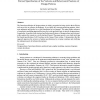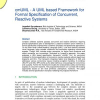JSS
2010
13 years 8 months ago
2010
The formal specification of design patterns is widely recognized as being vital to their effective and correct use in software development. It can clarify the concepts underlying ...
TCS
2002
14 years 1 months ago
2002
We show how formal specifications can be integrated into one of the current pragmatic object-oriented software development methods. Jacobson's "Object-Oriented Software ...
RE
2002
Springer
14 years 1 months ago
2002
Springer
A limiting factor in the industrial acceptance of formal specifications is their readability, particularly for large, complex engineering systems. We hypothesize that multiple vis...
KBS
2006
2006
Facilitating formal specification acquisition by using recursive functions on context-free languages
14 years 1 months ago
Although formal specification techniques are very useful in software development, the acquisition of formal specification is a difficult task. This paper presents the formal softw...
JOT
2008
14 years 1 months ago
2008
We present, in this paper, a framework supporting a formal verification of concurrent UML models using the Maude language. We consider both static and dynamic features of concurre...
JOT
2008
14 years 1 months ago
2008
Complex software systems possess concurrent and reactive behaviors requiring precise specifications prior to development. Lamport's transition axiom method is a formal specif...
ENTCS
2006
14 years 1 months ago
2006
Patterns for property specification enable non-experts to write formal specifications that can be used for automatic model checking. The existing patterns identified in [6] allow ...
FIW
1998
14 years 3 months ago
1998
We present a method to systematically detect feature interactions in requirements, which are expressed as constraints on system event traces. We show its application on the lift sy...
SERP
2003
14 years 3 months ago
2003
A software specification is a fundamental work product that represents user’s requirements and developers can use it to further develop a software system. A software specificati...
FORTE
2004
14 years 3 months ago
2004
Eliciting, modeling, and analyzing the requirements are the main challenges to face up when you want to produce a formal specification for distributed systems. The distribution and...


